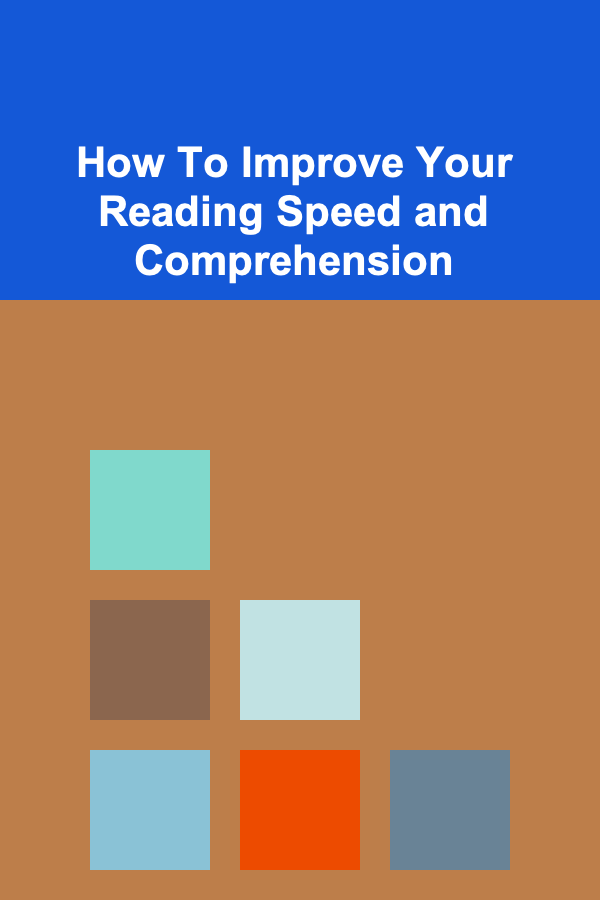
How To Improve Your Reading Speed and Comprehension
ebook include PDF & Audio bundle (Micro Guide)
$12.99$11.99
Limited Time Offer! Order within the next:

Reading is a skill that transcends simple book consumption; it serves as a tool for knowledge acquisition, critical thinking, and effective communication. Whether you're reading for academic purposes, work, or leisure, improving both reading speed and comprehension is essential for maximizing the time you spend engaging with written material. In this article, we'll explore the relationship between reading speed and comprehension, the factors that affect both, and practical strategies that you can adopt to enhance these skills.
Understanding Reading Speed and Comprehension
What is Reading Speed?
Reading speed is the rate at which you process and understand written material. It's typically measured in words per minute (WPM). Some people read quickly, while others take more time to absorb the same material. Speed, however, doesn't always equate to effectiveness. In fact, speed reading often comes at the cost of full comprehension. Reading speed can vary significantly based on the type of material, the reader's familiarity with the content, and individual reading habits.
What is Reading Comprehension?
Reading comprehension refers to the ability to understand, retain, and analyze what you've read. It's not enough to read words on a page --- you must also be able to interpret their meaning, make inferences, and apply the knowledge you've gained. Comprehension involves the integration of new information with prior knowledge and often requires active engagement with the text.
While speed and comprehension are often viewed as opposing forces (i.e., faster reading leads to reduced understanding), the goal is to balance both. Speed should not come at the expense of comprehension, and vice versa. Instead, by using specific techniques, you can boost both.
Factors That Affect Reading Speed and Comprehension
Before diving into strategies, it's essential to understand the factors that influence both reading speed and comprehension. These can range from external factors, such as the type of material, to internal factors, like individual cognitive abilities and habits.
1. Content Familiarity
The more familiar you are with the content, the faster you can read it without sacrificing comprehension. For example, if you're reading an article on a topic you know well, your brain processes the information more efficiently, allowing you to speed through the material without losing understanding. On the other hand, unfamiliar topics may slow you down as you try to decipher new vocabulary or concepts.
2. Text Complexity
The complexity of the text you're reading plays a significant role in both speed and comprehension. Complex academic papers or dense literature demand slower, more deliberate reading, while lighter material, such as novels or newspapers, may be read faster without much loss of understanding.
3. Concentration
Your ability to focus directly impacts both reading speed and comprehension. Distractions and multitasking can decrease your ability to retain information, even if you are reading at a fast pace. A high level of concentration allows you to absorb information more quickly and retain it for longer periods.
4. Reading Habits
Your reading habits --- including the way you approach reading, your level of engagement with the material, and your technique --- influence how effectively you read. Bad habits, such as subvocalization (reading aloud in your head), can slow you down, while good habits, like previewing material and skimming, can improve speed without compromising understanding.
5. Vocabulary Knowledge
A robust vocabulary allows you to read more efficiently. If you understand the majority of words in a text, you can process it more quickly and easily. Lack of vocabulary knowledge may slow down comprehension and force you to stop frequently to look up words.
Strategies to Improve Reading Speed
Now that we've covered the factors affecting reading, let's dive into some practical strategies for improving reading speed. The goal is not just to read faster, but to read faster while maintaining or even improving comprehension.
1. Preview the Text
Before diving into a book or article, quickly skim the text. Look at the headings, subheadings, and any bold or italicized words. This will give you a sense of the structure and main ideas. When you have a clear outline of what to expect, your brain can process the information more efficiently, allowing for faster reading.
2. Eliminate Subvocalization
Subvocalization, the habit of silently pronouncing each word as you read, is one of the primary reasons why people read slowly. While it helps with comprehension in some cases, it also limits how fast you can read. Instead of reading each word aloud in your head, try to focus on visualizing the ideas or concepts behind the words. This will allow you to read in larger chunks, speeding up your overall reading speed.
3. Practice Chunking
Chunking involves grouping multiple words or phrases together and reading them as a single unit rather than individual words. When you read word by word, your eye movements become jerky, and you waste time between words. By training your eyes to read groups of words at a time, you can speed up the process without losing understanding. To practice chunking, try to consciously read groups of three or more words at once.
4. Use Peripheral Vision
Your peripheral vision can help you read faster. Instead of focusing only on a single word, try to expand your gaze to include several words at once. With practice, you can train your peripheral vision to pick up more words and increase your reading speed. This can be especially helpful for reading dense or technical material.
5. Practice Speed Reading Techniques
There are many formal speed reading techniques that can help increase reading speed. Some of the most popular methods include:
- The RSVP Method (Rapid Serial Visual Presentation): This technique presents words one by one at a fast pace, allowing you to focus on each word and increase your reading speed.
- Pointer Method: Using a finger or pen to guide your eyes across the text helps maintain focus and minimizes distractions. This also encourages you to move your eyes faster.
- Regression Reduction: Regression refers to the habit of going back and rereading sections of text. Try to minimize this tendency, as it slows down the reading process. Training yourself to trust your initial reading will help you read more efficiently.
6. Set Reading Goals
Setting reading goals, such as a specific number of pages or chapters to read within a set time frame, can help you stay focused and motivated. Using a timer to keep track of how long you spend on each section can also help train your mind to read more efficiently.
Strategies to Improve Reading Comprehension
Improving reading comprehension involves developing the ability to understand, retain, and apply what you've read. Here are some strategies to help you achieve this:
1. Active Reading
Active reading involves engaging with the text as you read it. This means asking questions, making predictions, and summarizing key points. Active reading helps you retain the material better and improves your ability to analyze it.
You can use techniques such as:
- Highlighting: Mark key passages to revisit later.
- Annotating: Write notes in the margins to track your thoughts, questions, and reflections.
- Summarizing: After each section, pause and briefly summarize what you've read in your own words.
2. Take Breaks
Reading for long periods without breaks can reduce comprehension. Your brain needs time to process and consolidate information. Try to break your reading sessions into smaller chunks, such as 25-30 minutes of reading followed by a 5-10 minute break. This strategy, known as the Pomodoro Technique, helps maintain focus and reduces mental fatigue.
3. Relate New Information to Existing Knowledge
One of the most effective ways to improve comprehension is to connect new material to what you already know. This creates mental associations that make the new information easier to understand and remember. For instance, when reading about a new concept in physics, try to relate it to something you've learned in everyday life.
4. Ask Questions While Reading
When you read a text, ask yourself questions such as:
- What is the author's main argument or point?
- How does this information relate to what I already know?
- What examples or evidence support the author's claims?
By asking these questions, you become more actively engaged with the material, which helps improve both comprehension and retention.
5. Practice Retention Techniques
After reading a section or chapter, try to recall key points without looking at the text. This is known as retrieval practice, and it has been shown to improve long-term retention. If you find it difficult to recall everything, don't worry --- simply go back and read the material again to reinforce the information.
Conclusion
Improving your reading speed and comprehension is not an overnight process, but with consistent practice, you can see significant progress. By incorporating techniques such as previewing text, eliminating subvocalization, chunking, and engaging in active reading, you can improve both your speed and understanding of written material. Remember, the key is to strike a balance between speed and comprehension, ensuring that you not only read faster but also retain and apply what you read effectively. With patience, persistence, and the right strategies, you can unlock your full reading potential.

How to Make the Most of Nooks and Crannies for Extra Storage
Read More
How to Refresh Your Walls with Budget-Friendly Paint and Wallpaper Ideas
Read More
How To Write a Strong Follow-Up Email After No Response
Read More
Mastering the Psychology of Success
Read More
How to Plan a Recipe Planner for Food Allergy Management
Read More
10 Tips for Growing Indoor Mushrooms
Read MoreOther Products

How to Make the Most of Nooks and Crannies for Extra Storage
Read More
How to Refresh Your Walls with Budget-Friendly Paint and Wallpaper Ideas
Read More
How To Write a Strong Follow-Up Email After No Response
Read More
Mastering the Psychology of Success
Read More
How to Plan a Recipe Planner for Food Allergy Management
Read More